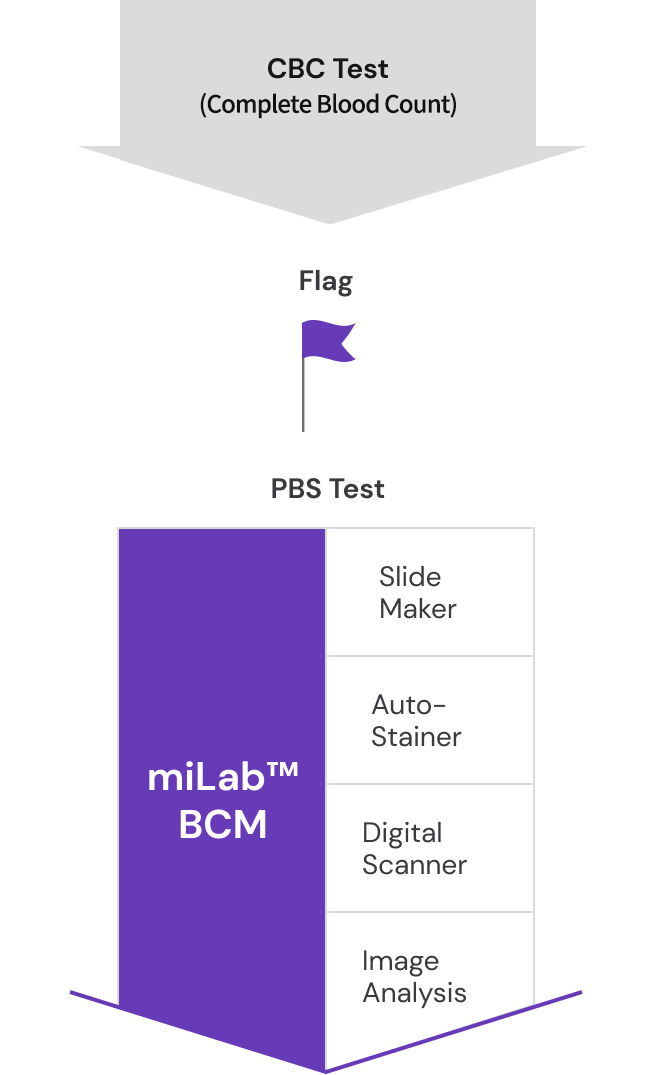This website uses cookies so that we can provide you with the best user experience possible. Cookie information is stored in your browser and performs functions such as recognising you when you return to our website and helping our team to understand which sections of the website you find most interesting and useful.
The Automatic Peripheral Blood Smear Test Solution,
miLab™ BCM
miLab™ BCM is an automated peripheral blood smear test solution that integrates the entire process of sample preparations, including blood smear, fixation, staining, and the functionality of digital microscopy, including digital imaging and AI analysis. With miLab™ BCM, local diagnostic laboratories or medical institutions without experts can independently provide complete peripheral blood smear tests. As the occasion demands, those local laboratories can share the digital images of the tests for the remote access of experts.

miLab™ BCM focuses on improving access to basic blood test.
Blood cell analysis is the most common diagnostic test in the world, but many people are still excluded from accessing these tests due to access to healthcare constraints in areas with insufficient infrastructure and experts.
Current Status of Global Blood Cell Analysis
* Year 2021
Current status of peripheral blood smear test and limitations of conventional methods
- Composition of eight fine-grained steps, from reagent preparation to blood smear, fixation, drying, staining, cleaning, analysis
- Separate laboratory space and various reagents and tools are required for each stage of work
- Through the operation of a microscopic diagnostic laboratory, fixed expenses totaling hundreds of thousands of dollars are incurred annually relating to infrastructure construction and maintenance, equipment purchasing, and employment of professional personnel
- The proportion of labor costs for experts exceeds 70%. Labor costs have risen sharply due to the recent increase in demand for diagnostic tests
- In low and middle-income countries and primary medical institutions, quality management and education systems for experts are insufficient
- A number of studies have identified an agreement rate of less than 50% between pathologists and technicians
- After COVID-19, diagnostic test experts are concentrated in urban areas where demand for diagnostic tests is high, further depriving rural communities of much needed expertise
- Medical institutions in northern Spain are experiencing a chronic shortage of experts
Automation of the Entire Testing Process: Integrates the Entire Process from Blood Smearing and Staining to AI Analysis of Digital Images
- (Integration) Integration of the microscopic diagnosis process
-
- Solid staining technology dramatically simplifies existing processes such as staining, washing and drying
- Smart cartridges replace reagents and tools required for traditional microscopic diagnosis
- (Automation) Full automation from sample preparation to AI analysis
-
- Automation of the entire process including smear, staining, digital imaging and AI analysis
- Experts can work on other tasks while miLab™ is conducting microscopic diagnosis
- (Classification) Blood cell classification by embedded AI
-
- AI analysis provides pre-classification by blood cells
- Can use stored digital images of former tests for the user education/training purpose
- (Digitalization) Remote access of the stored digital images
-
- Users can view the results any time, anywhere, by accessing the miLab™ platform remotely through an internet connection
- Provide urban area quality medical expertise to remote areas with insufficient access to experts
Provides differentiated
value by improving
accessibility and
workflow according to the
actual needs of users
- 1. Local Medical Institutions that Want to Provide Peripheral Blood Smear Tests Independently
-
- Target Customers
- Medical institutions that already installed CBC equipment but cannot perform the microscope-based peripheral blood smear tests independently.
- Expected Value
- Expand revenues by offering peripheral blood smear tests.
- Background
- Most hematology laboratories already installed CBC equipment. CBC inspection has the advantage of being quick and easy to use, but the level and accuracy of analysis are not high enough due to the limitations of technology. The CBC test can only determine whether the patient's blood condition is in the normal range or not. However, it is difficult to specify what abnormalities caused blood condition outside the normal range. Usually, 15-20% of patients visiting the hospital have blood conditions out of the normal range, and such patients need additional tests, such as peripheral blood smear tests based on microscopy, to determine the cause.
- Problem
- For medical institutions without peripheral blood smear tests capability, it is difficult to specify the reason why patients have a blood condition outside of the normal range indicated by CBC tests. In this case, samples should be delivered to an external specialized diagnostic laboratory or a higher-level medical institution for peripheral blood smear tests to clarify the patient's diagnosis and treatment plan. This process is time consuming and incurs additional costs for shipping the sample.. Therefore, emergency patients or patients who need periodic blood tests have no choice but to be referred to higher-level medical institutions.
- Use-Case
- The introduction of miLab™ BCM allows local medical institutions to perform peripheral blood smear tests independently on the patients whose blood was indicated to be in an abnormal range by the CBC test.. They can provide additional care for the patients based on the results of the miLab™ BCM analysis. Local medical institutions can identify patients’ conditions more quickly and accurately, allowing doctors to determine whether a patient should be referred to a higher-level hospital or not.
- Benefits
- With miLab™ BCM, local medical institutions can provide additional peripheral blood smear tests. Expanding the medical services for patients can increase the number of visits and the duration of treatment, which leads to additional revenue. From the perspective of the overall medical system operation, more local medical institutions with blood smear testing capability can reduce traffic and organizational challenges for patients in advanced hospitals.
- 2. Medical Institutions that Want to Optimize the Workflow on Peripheral Blood Smear Test
-
- Target customers
- Medical institutions operating a diagnostic laboratory for peripheral blood smear tests, where experts still perform diagnostic tests using traditional, labor-intensive processes.
- Expected Value
- Automated peripheral blood smear tests can improve workflow and productivity.
- Background
- A typical peripheral blood smear test is composed of labor-intensive processes. The sample preparation stage has blood smear, fixation, staining, washing, and drying processes which are all carried out manually. In the microscopic analysis stage, experts check the shape and distribution of blood cells one by one with a microscope.
- Problem
- Due to the labor-intensive processes, physical fatigue increases with the number of peripheral blood smear tests performed. Higher fatigue in experts can lead to an increased likelihood of human error. Each medical expert can only perform a set number of tests in a specific time period without compromising the gold standard process that all medical institutions should follow.
- Use-Case
- Medical institutions that want to increase productivity in peripheral blood smear tests can introduce miLab™ BCM to automate some or all of the process done by experts. The miLab™ BCM automatically performs the entire process from sample preparation to AI-based prehemocyte classification. Therefore, experts will be able to focus on reviewing and finalizing results on the monitor screen without checking each blood cell under a microscope. While experts are unavailable, other staff members can work with miLab™ BCM. When experts return, they can review and finalize the pre-analyzed results stored in the database.
- Benefits
- Medical institutions using miLab™ BCM can perform more tests than those using traditional processes given the same number of people and time. Medical institutions can respond to the growing demand for peripheral blood smear tests by introducing miLab™ BCM without hiring more experts. Higher productivity is more valuable in high-income countries where labor costs are high.
- 3. Medical Institutions That Want to Improve the Accuracy of Peripheral Blood Smear Tests
-
- Target customers
- Medical institutions that have their own diagnostic laboratories but conduct peripheral blood smear tests with low-skilled experts.
- Expected Value
- Enhancing quality assurance and quality management systems to improve the reliability of peripheral blood smear tests
- Background
- Typically, experts performing peripheral blood smear testing require specialized knowledge and experience as professional healthcare experts at the national level. In addition to completing professional education above the university and passing the national qualification exam, regular practical education and training are also required. In countries with well-equipped medical education facilities and systems such as the Republic of Korea, the level of experts is maintained. However, in middle and low-income countries, medical education facilities and systems are insufficient.
- Problem
- Because the peripheral blood smear test is carried out in a labor-intensive manner, the analysis and judgment results vary depending on the proficiency of the expert. Incorrect analysis results from the peripheral blood smear test lead to incorrect diagnosis and treatment of the patient. Healthcare organizations can compare the results by having multiple experts perform tests simultaneously to ensure that the results are accurate, or have a proven expert verify the results. However, all of these methods incur additional cost burdens, such as hiring highly qualified personnel.
- Use-Case
- For healthcare organizations that want to improve the accuracy of peripheral blood smear testing, miLab™ BCM can be included in their quality control system. miLab™ BCM standardized peripheral blood smear's core processes. Therefore, the reliability of experts can be confirmed by comparing the results of the peripheral blood smear test with the results of the miLab™ BCM. In addition, digital data generated by miLab™ BCM can be used for education and training materials for low-skilled experts.
- Benefits
- Medical institutions using miLab™ BCM can strengthen the peripheral blood smear test quality and verify the reliability of experts. In addition, experts can be trained and educated in low and middle-income countries that lack medical education facilities and systems utilizing the digital data of miLab™ BCM as educational and training materials.
- 4. Medical Institutions That Want to Perform the Remote peripheral blood Smear Tests
-
- Target customers
- Medical institutions that are not capable of peripheral blood test nor have higher-level hospitals with experts nearby to ask for consignment examinations.
- Expected Value
- Improving medical access for patients marginalized from the existing medical system.
- Background
- In remote and mountainous regions where physical access is not easy or in low and middle-income countries where specialized educational facilities are scarce, there are not enough experts to conduct peripheral blood smear tests. In some areas, there are no medical institutions capable of performing the peripheral blood smear tests.
- Problem
- Residents living in such areas, where it is difficult to take the peripheral blood smear test, have the inconvenience of traveling a long distance to get a test. Due to this inconvenience, they may not receive regular cervical cancer screening tests, which leads to being exposed to the risk of disease.
- Use-Case
- Medical institutions capable of collecting cervical cells in such areas can share digital data to ask remote experts for precise readings.
- Benefits
- With the introduction of miLab™ BCM, those medical institutions can improve residents' access to basic screening to help residents diagnose disease early and receive appropriate and timely treatment.
- 5. Special Situation
-
Microscope-based peripheral blood smear testing is the most basic diagnostic testing to check the patient's health. In addition to customer types above, we are looking for product applicability in a variety vases.
In particular, regarding miLab™ BCM, there are various market opportunities that have yet to be confirmed, such as situations that require basic blood tests in resource0constrained environments, and blood tests for infants and toddlers that requires tests with fingertip blood collection.
Do not hesitate to contact us anytime if you are interested in using miLab™ BCM products under special circumstances.
Detect the target cells
in 15 min.
- miLab™ BCM Specification
-
- Sample Preparation
-
Smear method Automated ideal zone smear Staining method Modified Romanowsky Sample type Venous blood Sample volume 4μℓ
- Imaging
-
Focus Multi-focus, Multi-layer analysis (10 vertical-planes) Imaging Automatically detects and captures 200 WBCs
- Analysis
-
WBC 5-Part
Differential & Others- Neutrophil (#, %, images)
- Lymphocyte (#, %, images)
- Monocyte (#, %, images)
- Eosinophil (#, %, images)
- Basophil (#, %, images)
- Others (images)
# (WBC's number) = Each counted number of WBC types among the total counted WBC.
Viewing Functions Context view, Multi-focus view (10 vertical-planes)
- Total Test Time
-
Avg. 18 mins
- Remote Review
-
Viewing Functions Field View, Cell View, Cell Reclassification, Report
- Product Code
-
-
Product Code miLab™ Platform DMLA miLab™ Cartridge BCM CBCA miLab Viewer™ SMVA SafeFix™ CSFA miLab™ Slide Case ASCA
-



















The miLab™ platform is the only diagnostic platform in the world that follows the Gold Standard microscopic examination and diagnostic process. Microscopic diagnostics vary widely in sample preparation and diagnostic results depending on the skill of the technician or medical staff, but miLab™ has dramatically reduced errors by fully automating all of these processes.
by Hans-Peter Beck
University of Basel, Swiss TPH